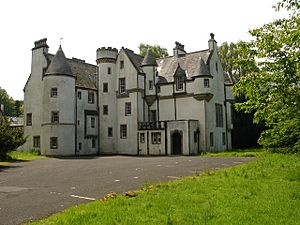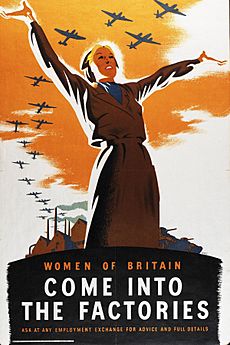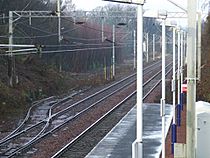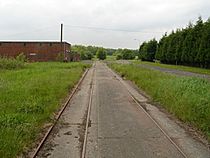ROF Bishopton facts for kids
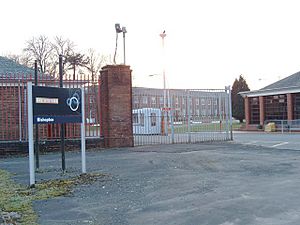
Entrance gates
|
|
| Built | 1937 |
|---|---|
| Location | Bishopton, Scotland |
| Coordinates | 55°54′04″N 4°30′15″W / 55.9010°N 4.50429°W |
| Industry | Defence |
| Products | Munitions |
| Employees | 20,000+ (approx) |
| Area | 2350 acres (890 acres within perimeter fence) |
| Defunct | 2002 |
The Royal Ordnance Factory was a huge factory built during World War II (WW2). It was located near the village of Bishopton in Scotland. This factory made special materials called cordite. Cordite was used as a propellant, which means it helped fire bullets and rockets for the British Army, the Royal Air Force, and later the Royal Navy. It was the biggest factory of its kind for the Ministry of Defence, employing over 20,000 people at its busiest time.
Contents
Factory History
This important explosives factory started working between December 1940 and April 1941. It was one of only three factories in the UK built to make propellants for the government. The other two were ROF Wrexham and ROF Ranskill. Parts of the Bishopton factory continued to make things until 2002. Today, the land is owned by BAE Systems. They are working with Redrow Homes to build new houses on the site. This new area is now called Dargavel Village.
About the Site
Where it Was Built
The factory was built on farmland. The government bought this land using a special order called a compulsory purchase order. This meant they could buy the land even if the owners didn't want to sell it. More than 2,000 acres (about 8 square kilometers) from seven different farms were used. A historic building called Dargavel House was on this land. It still stands within the factory's old boundaries. Some old farmhouses and roads were also included inside the factory area.
The factory was built close to sea level. This was important because explosives factories needed a special kind of weather, called a microclimate, which was found near the coast. Some higher parts of the site were used for making nitroglycerin.
Another reason this spot was chosen was because many people in the area didn't have jobs in the 1920s and 1930s. This meant there were lots of women available to work in the factory. Good railway connections nearby also helped decide the location.
The site had three almost separate factories, each making explosives. They shared a main office and workshops. Building started on the first factory in 1937. The second began in 1939, and the third later that year. There was a big delay in opening the first factory because they needed a lot of water. The site had three different water systems: one for fighting fires, one for making products, and one for drinking water. They needed about ten million gallons of water every day!
Factory 0: Support Services
Every building at the factory had a number. Part of the number showed if the building belonged to Factory 0, 1, 2, or 3. Factory 0 was closest to Bishopton village. It held most of the support services that the other factories needed.
Factory 0 had many important areas. These included a fire station with its own firefighters, a clothing department, and general stores. It also had laboratories for testing, workshops for repairs, a laundry, and places to fix leather and wood. The main office, several canteens, an ambulance station, a medical center, and a place for vehicles were also in Factory 0.
Factories I, II, and III: Production Areas
Factories I, II, and III each had their own power stations. These stations burned coal to make high-pressure steam. This steam was used to create electricity. The leftover steam was then used to heat the buildings and dry the cordite. The three power stations were also connected to each other.
Each of these factories had three "nitroglycerin hills." Here, they made nitroglycerin in batches. Factories I and II also had plants to make nitrocellulose. Both nitroglycerin and nitrocellulose were then used to make cordite.
Most of the buildings were very strong. They had steel frames, thick brick walls, and concrete roofs that could withstand bombs. Some buildings in Factory III, which was built last, used corrugated iron to save money.
During World War II, the factory also had a plant to make RDX, another type of explosive. This plant was taken apart in 1950. It was reportedly sent to Australia and rebuilt there. The site also had a storage area for armoured fighting vehicles. This area was connected to a repair factory in Linwood.
Factory Railways
The factory had a railway connection to the main train lines. This connection was used to bring materials in and take finished products out. The factory had its own railway system inside its fences.
There were about 20 miles (32 km) of standard gauge railway lines inside the factory. This is the normal width for train tracks. The factory had its own special wagons for carrying nitric acid. It also had diesel locomotives (train engines) to move wagons around the site.
In addition, the factory had about 80 miles (129 km) of narrow gauge railway lines. These tracks were much narrower, about 2 feet 6 inches (76 cm) wide. These smaller trains were used to move explosives safely around the site. The factory had many small trains and a special workshop to keep them in excellent condition. Many of these narrow gauge trains and wagons still exist today. You can see some of them at places like the Almond Valley Light Railway and the Amberley Museum Railway.
Housing for Workers
Houses were built in Bishopton for the Ministry of Defence Police officers who worked at the factory. Two streets, Holmpark and Rossland Crescent, had homes for married police officers. Single police officers lived in a building next to Holmpark. This building later became a social club. Some temporary houses were also built in Rossland Crescent, but they have since been taken down. Houses for important staff, like managers who needed to be available at all times, were built on Poplar Avenue. A hostel for single women workers was built in Paisley.
Factory Changes and Closure
The number of workers at the factory changed over time. In the late 1970s, there were about 3,000 employees. By 1984, when the factory became a private company, the number dropped to 2,000. In 1987, British Aerospace bought the Royal Ordnance Factories.
During the 1990s, a lot of money was spent to make the factory more modern. They used machines to make nitroglycerin, nitrocellulose, and nitroguanidine. This made production better and safer. Before it closed, the factory made propellants for many different weapons.
The number of workers kept going down. There were about 1,000 employees in 1991, then 600 in 1993, and 450 in 1996. In 1998, it was announced that the factory would close. This happened after the factory lost a big government contract to supply ammunition. Manufacturing at the site stopped in June 2002.
After the factory became private, the MOD Fire Service and MOD Police moved out. Their old social club and sports field became part of Bishopton village. The houses where the MOD Police used to live were sold to private buyers in the mid-1980s.
BAE Systems now owns the site. They have a small testing facility and a laboratory there. The rest of the land is being turned into new homes.


